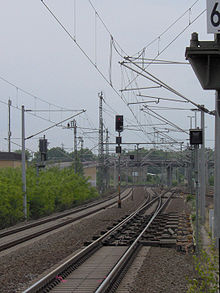- Dessau–Leipzig railway
-
Dessau–Leipzig Hbf Route number: 251 Line number: 6411 Line length: 58.3 Gauge: 1435 Voltage: 15 kV, 16.7 Hz AC Maximum speed: 200 Legend
from Magdeburg 
23.0 Dessau 
to Köthen 
B 184, B 185 
to Radegast 
27.3 Dessau Süd 
29.6 Haideburg 
A 9 
34.3 Marke 
37.7 Raguhn 
40.9 Jeßnitz 
43.3 Wolfen 
45.5 Greppin 
from Stumsdorf and from Berlin 
B 183 
48.5 Bitterfeld 
B 100 
to Halle (Saale) 
55.0 Petersroda 
Saxony–Saxony-Anhalt state border 
B 183a 
60.4 Delitzsch low level station 
to Halle (Saale) 
Halle–Cottbus railway 
from Halle (Saale) 
65.1 Zschortau 
Delitzsch light railway 
70.0 Rackwitz 
Connecting curve from light railway 
B 184 
A 14 
from Halle (Saale) 
74.3 Leipzig Messe 
from Leipzig-Wahren (freight ring) 
B 2 
to Engelsdorf (freight ring) and to Eilenburg (–Cottbus) 
Parthe 
from Halle (Saale) and from Großkorbetha 
from Dresden 
81.3 Leipzig Hbf The Dessau–Leipzig railway is a double track electrified main line in the German states of Saxony-Anhalt and Saxony built and originally operated by the Berlin-Anhalt Railway Company. The section from Bitterfeld to Leipzig is part of Line 1 of Trans-European Transport Networks (TEN-T).
Contents
History
Planning and Construction
The Berlin-Anhalt Railway Company (German: Berlin-Anhaltische Eisenbahn-Gesellschaft) was for more than four decades in the 19th century one of the major railway companies in Germany. It built during this period a network of major rail links between Berlin and the northern part of the Kingdom of Saxony and the Prussian Province of Saxony and the Duchy of Anhalt, including the Anhalt trunk line. Its trunk line ran from Berlin via Wittenberg and Dessau to Köthen, where it connected with the Magdeburg-Leipzig line to Halle and Leipzig. In order to shorten the route to Halle and Leipzig, the company built direct lines from Dessau via Bitterfeld to Leipzig and Halle in the late 1850s. The section from Dessau to Bitterfeld was opened on 17 August 1857. On 1 February 1859 this was followed by the opening of the sections from Bitterfeld to both Halle and Leipzig. On 3 August 1859, a shorter line was opened between Berlin to Leipzig on a direct route between Wittenberg and Bitterfeld.
Part of the Bitterfeld-Dessau section was electrified experimentally in 1911 and on 5 June 1914 the Bitterfeld-Leipzig section was electrified. This was switched off on 1 August 1914, following the oubreak of World War I. In 1922 electrification was restored. In March 1946 electrification was discontinued as the equipment had been demanded by the Soviet Union as reparations for World War II. On 9 July 1958 electrification was again restored on the line.
After 1990
With German reunification the line became less important. The Städteexpress (city express) trains that had run under the Coummunist regime were discontinued on 31 May 1991 and replaced by Intercity and InterRegio services.
In 1991, upgrading of the line from Berlin to Halle and Leipzig commenced as part of the German Unity Transport Projects—rail project 8.3. In the mid-1990s, the upgrade was sufficiently advanced for speeds on a section of it to be raised to a maximum of 160 km/h. For the raising of speeds to 200 km/h, further work was required, in particular the elimination of many level crossings. Completion of this work, in 1999, at a cost of 3.5 billion Deutsche Marks cut travel time between Halle/Leipzig and Berlin to under an hour.[1] Various improvements had been made to the line, including the eliminating of all crossings and the modernisation of all stations. A radio-based train protection system was installed.[2] A timetable change in May 2006 raised speeds largely to 200 km/h on the upgraded section of the line between Bitterfeld and Leipzig.
References
- ^ "... und ab 1999 in einer Stunde von Berlin nach Halle/Leipzig (... and from 1999 in an hour from Berlin to Halle/Leipzig)" (in German). Eisenbahn-Kurier (278): 21. November 1998. ISSN 0170-5288.
- ^ (in German) Verkehrsprojekte Deutsche Einheit. Sachstand: 1997 (German Unity Transport Projects. Assessment: 1997). Bonn: Federal Ministry of Transport. 1997. pp. 20 f..
Categories:- Railway lines in Saxony
- Railway lines in Saxony-Anhalt
Wikimedia Foundation. 2010.

